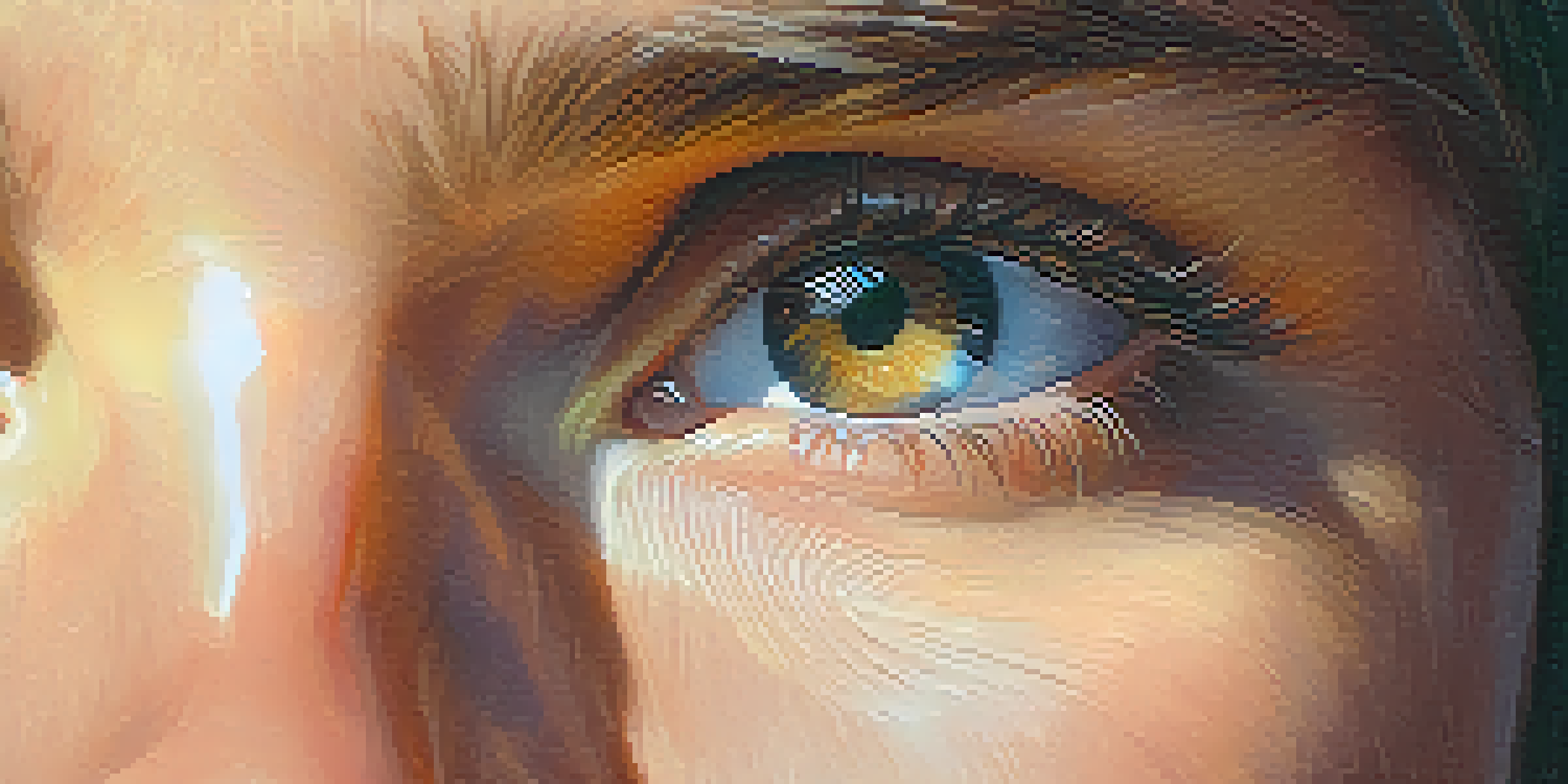Dynamic Camera Movement: Creating Intensity in Film

Understanding Dynamic Camera Movement in Filmmaking
Dynamic camera movement refers to the purposeful motion of the camera during a shot, which can significantly alter the audience's emotional experience. Unlike static shots that maintain a fixed perspective, dynamic movements can create a sense of urgency or intimacy, depending on their execution. This technique is often used to draw viewers deeper into the story, making them feel as if they are part of the action.
The camera is a powerful tool for storytelling, and its movement can evoke emotions just as much as the actors’ performances.
Think about action sequences where the camera follows a character running through a crowded street. The swaying motion can mimic the chaos of the environment, amplifying the viewer's adrenaline. Conversely, a slow, sweeping shot can evoke calmness or reflect on a character's emotional state, providing a moment of introspection amid the chaos.
Overall, dynamic camera movement is a powerful storytelling tool. It’s not just about visual flair; it’s about enhancing the narrative and emotional resonance. By understanding and utilizing this technique, filmmakers can create more engaging and intense cinematic experiences.
Types of Dynamic Camera Movements Explained
There are several types of dynamic camera movements, each serving a distinct purpose. Common examples include panning, tilting, tracking, and dolly shots. Panning involves moving the camera horizontally while keeping its position fixed, whereas tilting involves moving the camera vertically, both of which can reveal new information and perspectives.

Tracking shots, where the camera follows a subject, create a sense of motion and urgency. For instance, a tracking shot following a character through a suspenseful scene can heighten tension, making viewers feel as if they are right there with the character. Dolly shots, on the other hand, involve moving the entire camera closer or further away from the subject, allowing for dramatic reveals or emotional distance.
Dynamic Movements Shape Emotions
Dynamic camera movements can significantly enhance the emotional experience of a scene by drawing viewers into the narrative.
Each of these movements contributes to the overall storytelling by shaping how the audience perceives the action and emotional stakes. By choosing the right type of movement for a specific moment, filmmakers can guide viewers’ emotional responses and keep them engaged.
The Role of Camera Movement in Building Tension
One of the most impactful uses of dynamic camera movement is in building tension. For example, during a suspenseful scene, a shaky handheld camera can create a sense of instability and uncertainty. This approach immerses the audience in the character's experience, making them feel the anxiety and fear that the character feels.
In filmmaking, the camera is your voice, and how you move it is how you express the story.
Additionally, quick, jerky movements can mimic the erratic nature of a character's thoughts or emotions during a moment of crisis. Think of how a camera might dart around to capture every little movement and sound in a horror film, enhancing the fear factor. The unpredictability of the camera's movement can leave viewers on the edge of their seats.
Ultimately, the careful application of dynamic camera movement can heighten suspense and keep viewers invested in the unfolding narrative. By manipulating camera angles and movement, filmmakers can ensure that the tension builds naturally, keeping audiences engaged and emotionally connected.
Creating Emotional Connection Through Camera Movements
Dynamic camera movement is not just about action; it also plays a crucial role in creating emotional connections between characters and viewers. For instance, slow, deliberate movements can highlight a character's inner turmoil or vulnerability. By gently zooming in on a character’s face during a pivotal moment, filmmakers can capture subtle emotions that resonate deeply with the audience.
Conversely, rapid movements can showcase joy or excitement, as seen in celebratory scenes where the camera spins around characters, mirroring their elation. This technique invites viewers to share in the experience, fostering a sense of connection and empathy with the characters on screen.
Types of Movement Serve Purpose
Different types of dynamic camera movements, such as panning and tracking, uniquely contribute to storytelling by influencing audience perception.
By understanding how different movements can convey various emotions, filmmakers can craft scenes that resonate on a deeper level. This emotional connection is essential for creating memorable cinematic moments that linger in the viewer's mind long after the credits roll.
Using Camera Movement to Enhance Storytelling
Dynamic camera movement can serve as a narrative device, guiding the audience's focus and shaping the story's progression. For example, a slow reveal through a tracking shot can build anticipation before introducing a critical plot point. This technique encourages viewers to invest in the unfolding story, as they eagerly await what comes next.
Moreover, camera movement can signify shifts in tone or perspective. A sudden change from a steady shot to a chaotic handheld style can indicate a transition from calm to conflict, prompting the audience to adjust their emotional response accordingly. This use of movement can effectively communicate the story's evolving dynamics.
Incorporating dynamic camera movements into storytelling allows filmmakers to create a more immersive experience. By aligning camera techniques with narrative developments, they can enhance the emotional impact and keep viewers engaged throughout the film.
Practical Techniques for Effective Camera Movement
When implementing dynamic camera movements, it's essential to have a clear plan in mind. Filmmakers should consider the emotional tone of the scene and how different movements can enhance it. Storyboarding can be a valuable tool, allowing directors to visualize the desired impact before filming begins.
Additionally, practicing smooth transitions between movements is crucial for maintaining viewer immersion. Jarring or abrupt changes can break the audience's connection to the story. Techniques like using a gimbal or stabilizer can help achieve fluid camera movements, ensuring that the visual storytelling remains engaging and seamless.
Tension and Connection Through Movement
Effective use of dynamic camera techniques can build tension and foster emotional connections, keeping viewers engaged in the story.
Finally, experimenting with various techniques during rehearsal can lead to discovering innovative ways to enhance scenes. Filmmakers should keep an open mind and adapt their approach to find the movement that best serves the story and emotional tone.
Case Studies: Films That Master Dynamic Camera Movement
To truly understand the power of dynamic camera movement, examining films that excel in this area can be enlightening. Take 'Birdman,' for example; the film is known for its continuous shot effect, where the camera fluidly follows the characters through various settings. This technique not only creates a sense of real-time immersion but also intensifies the emotional stakes.
Another great example is 'Children of Men,' which employs long, unbroken takes with dynamic camera movement to heighten tension and urgency during chase scenes. The handheld style immerses viewers in the harrowing world the characters navigate, making them feel the weight of each moment.

These films demonstrate how effective dynamic camera movement can elevate storytelling, turning simple scenes into powerful emotional experiences. By studying these examples, aspiring filmmakers can learn how to incorporate similar techniques into their work.
Conclusion: The Power of Dynamic Camera Movement
In conclusion, dynamic camera movement is an invaluable tool for filmmakers looking to create intensity and emotional resonance in their work. By understanding the various types of movements and their effects, filmmakers can enhance storytelling and engage audiences on a deeper level. It’s about more than just movement; it’s about connecting with viewers through a shared emotional journey.
Whether building tension, fostering emotional connections, or enhancing narrative progression, dynamic camera movements can significantly impact how a story is perceived. Filmmakers who master this technique can create visually stunning and emotionally compelling experiences that leave a lasting impression.
As cinema continues to evolve, the importance of dynamic camera movement will remain, allowing storytellers to convey complex emotions and experiences in a visually captivating way. Embracing this technique is essential for anyone looking to leave their mark in the world of filmmaking.